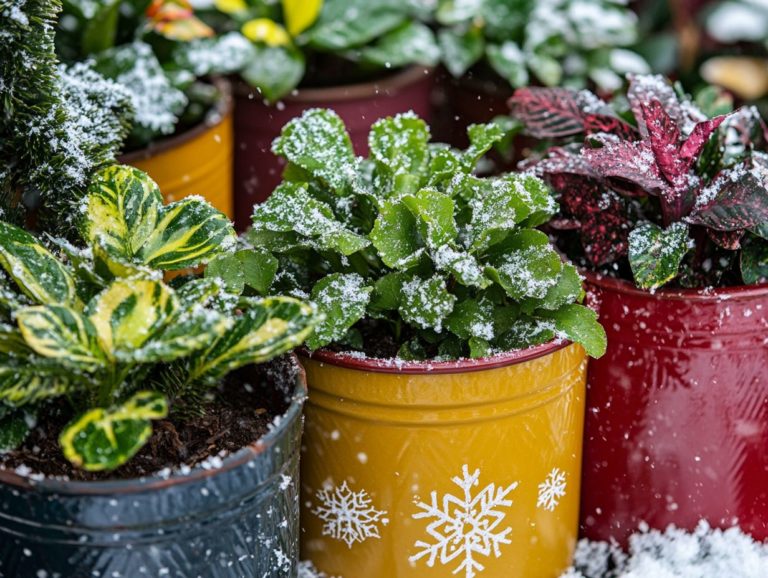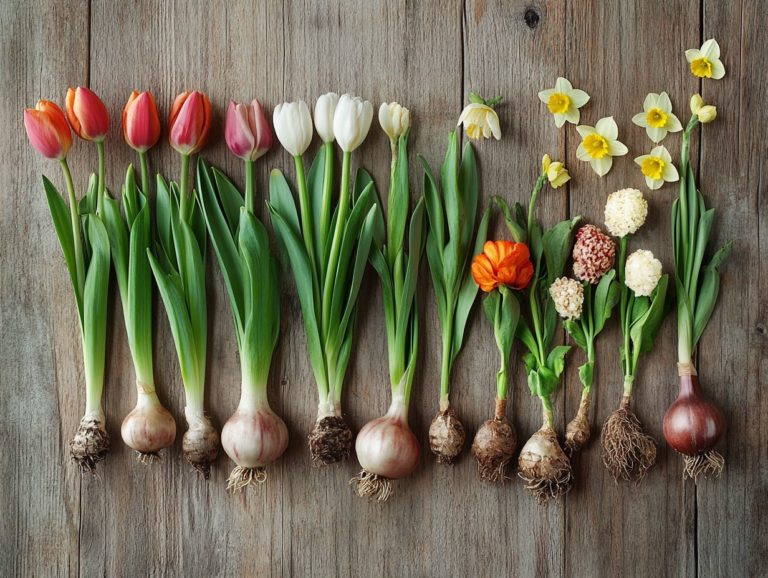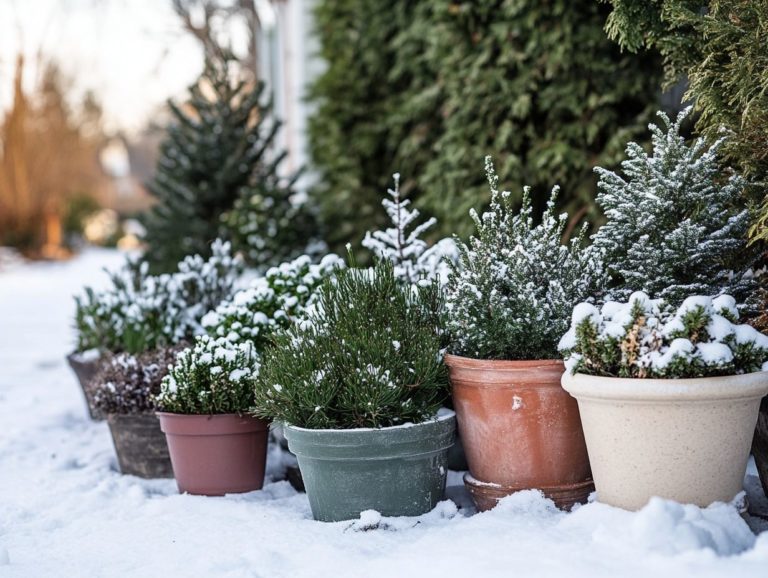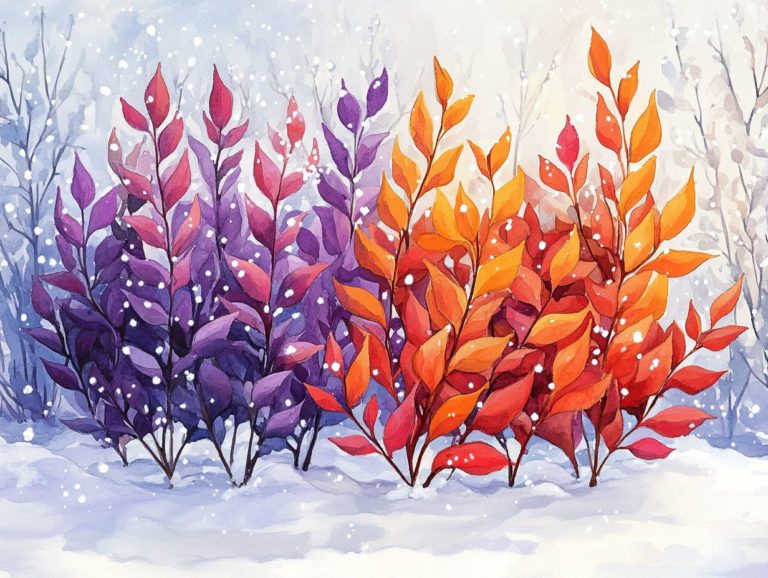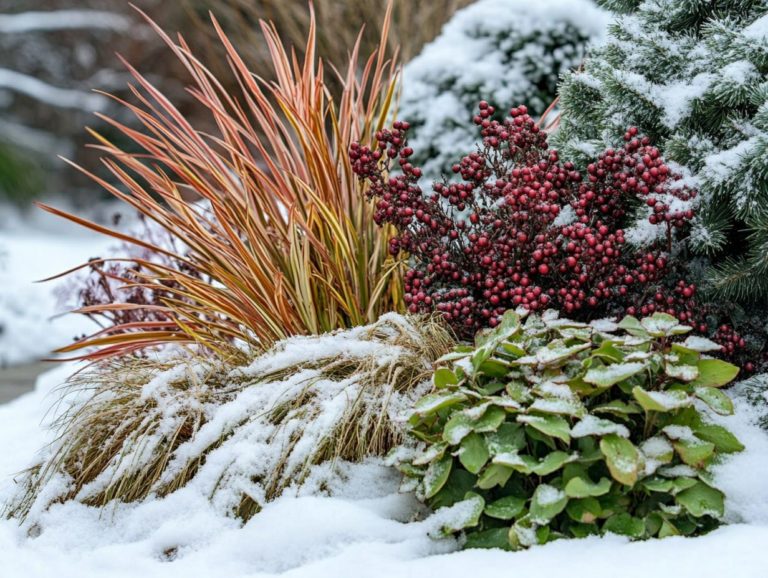Deciduous vs. Evergreen: What’s Best?
Choosing between deciduous and evergreen trees can be both a delightful and challenging decision for you as a gardener or landscape enthusiast.
Each type presents its own advantages, providing seasonal beauty, environmental benefits, and distinct care requirements. This article delves into the defining characteristics of both tree types, highlighting their seasonal and year-round benefits along with key factors to consider based on your climate and aesthetic preferences, including examples of both broadleaf and coniferous species.
You ll also discover essential tips for maintaining these trees and shrubs, ensuring they flourish beautifully in your space and contribute to the overall growth of your garden.
Contents
- Key Takeaways:
- Advantages of Deciduous Trees
- Advantages of Evergreen Trees
- Factors to Consider When Choosing Between Deciduous and Evergreen Trees
- Maintaining Deciduous and Evergreen Trees
- Frequently Asked Questions
- What is the difference between deciduous and evergreen trees?
- Which is better for the environment: deciduous or evergreen trees, and how do their types differ?
- Do deciduous or evergreen trees require more maintenance?
- Which type of tree is better for providing shade?
- Can deciduous and evergreen trees be planted together?
- How do I decide which type of tree is best for my yard?
Key Takeaways:
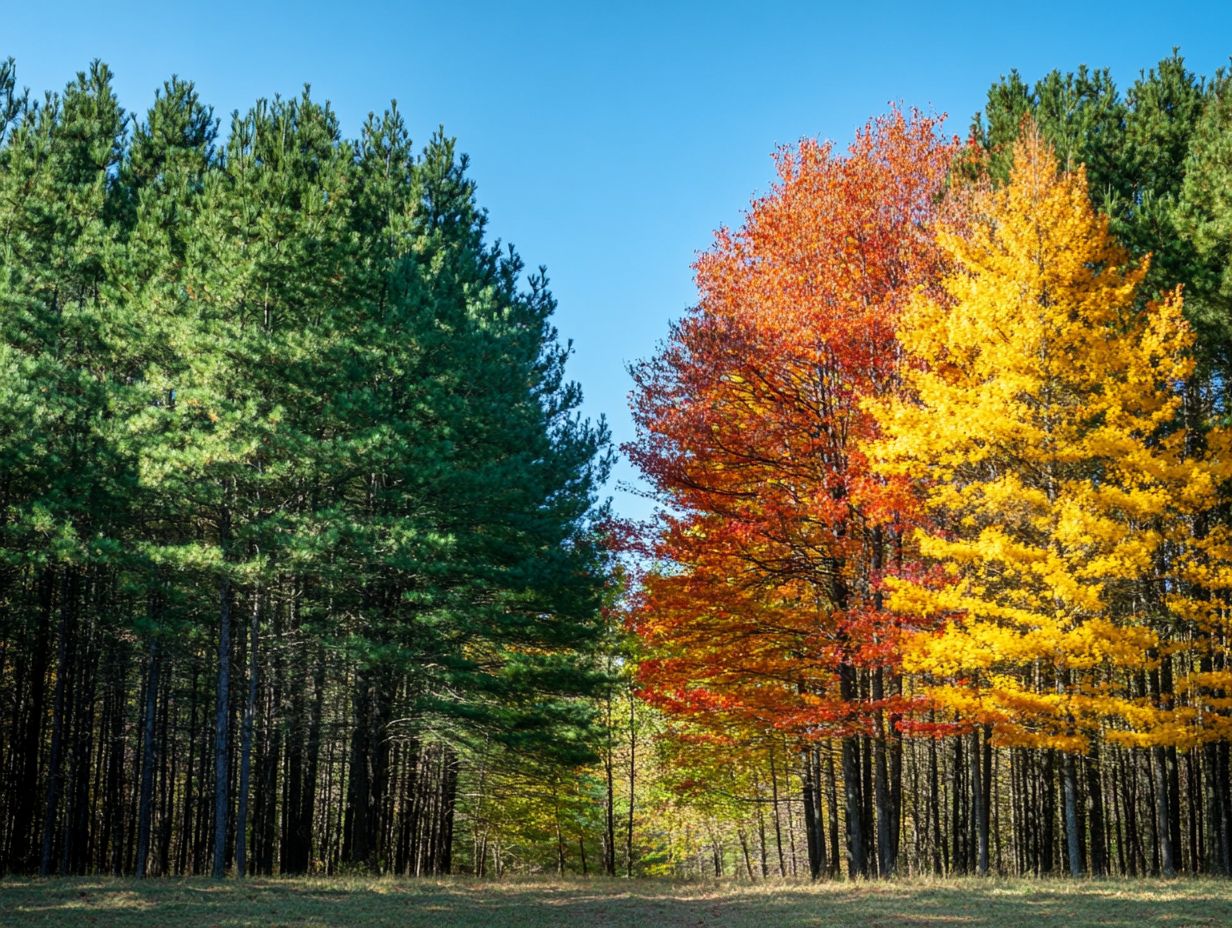
- Deciduous trees, such as the Bald Cypress and Yoshino Cherry Tree, offer seasonal benefits and positively impact the environment. They are excellent choices for those looking to maintain a balanced ecosystem.
- Evergreen trees, including Arborvitaes and Boxwoods, provide year-round benefits and have a positive impact on the environment. They are excellent options for those seeking consistent greenery and air purification.
- When choosing between deciduous and evergreen trees, consider your climate and aesthetic preferences to ensure the best fit for your lawn or garden. Proper pruning and care maintain the health and beauty of both types of trees.
Defining Characteristics
The defining characteristics of trees and shrubs can be categorized into two main types: deciduous and evergreen varieties. Each type presents unique traits that enhance the beauty of your landscape and contribute to ecological balance.
Deciduous trees are celebrated for their vibrant seasonal transformations. In the fall, they display stunning colors, with leaves turning shades of amber and crimson before gracefully falling to the ground. This shedding helps them save energy in winter, returning nutrients to the soil.
On the other hand, evergreens, with their needle-like or scale-like leaves, maintain a lush appearance all year round. They provide vital habitat and food sources for various wildlife, ensuring a thriving ecosystem. Their consistent greenery provides a lasting appearance in the landscape while playing an essential role in carbon sequestration, a process that helps absorb carbon dioxide from the atmosphere.
Both types of trees are integral to local ecosystems, offering shade, improving air quality, and supporting biodiversity. This is beneficial not just for wildlife but also enhances the overall beauty and functionality of your gardens.
Advantages of Deciduous Trees
Deciduous trees present a wealth of benefits that elevate the aesthetic charm and ecological integrity of your gardens and landscapes. Their seasonal changes in foliage bring a stunning array of colors in both spring and autumn, adding vibrancy to your outdoor spaces.
Take, for instance, the Wee Bit Giddy Hydrangea; it not only enhances beauty with its lush blooms but also plays a vital role in nutrient recycling within its ecosystem. This highlights the importance of proper maintenance and care practices, such as strategic pruning, to foster healthy growth and ensure these magnificent trees thrive in your landscape.
Seasonal Benefits and Environmental Impact
The seasonal advantages of deciduous trees are remarkable, as they enrich the environment by releasing valuable nutrients during their autumn leaf drop. This enhances soil health and creates vital habitats for wildlife when spring arrives with new growth.
As autumn draws near, you’ll witness the landscape transform, with foliage igniting in vibrant shades of orange, red, and yellow, captivating everyone who gazes upon it. When the leaves descend, they form a lush layer of organic matter on the forest floor, enriching the soil and enhancing nutrient cycling that nourishes a variety of plant life.
In spring, as buds begin to unfurl, these trees become crucial to local wildlife, providing food and shelter for various birds, insects, and mammals. This cyclical process nurtures a diverse ecosystem and elevates the aesthetic appeal of your surroundings, showcasing the dynamic beauty of nature throughout the seasons.
Embrace the beauty and benefits of both deciduous and evergreen trees. Your garden will thrive and bloom beautifully throughout the seasons!
Advantages of Evergreen Trees

Evergreen trees provide many benefits that make them essential for any garden. Their year-round foliage not only enhances privacy but also creates a verdant sanctuary, even in the depths of winter.
Consider species like the American Holly and Dawn Redwood; these trees not only provide consistent visual appeal but also serve as important homes for wildlife. They contribute to environmental stability.
Their significance cannot be overstated when it comes to thoughtful garden planning and maintenance.
Year-round Benefits and Environmental Impact
Evergreen trees offer incredible benefits all year long. They provide continuous cover, effectively reduce soil erosion, and support wildlife even in the harshest winter climates.
These majestic trees play a vital role in climate stability, absorbing carbon dioxide a gas that plants use to grow and releasing oxygen, which in turn enhances air quality. By creating dense canopies, they establish essential habitats for various bird species and local wildlife, fostering biodiversity.
Don t miss out on the amazing beauty evergreens bring to your landscape! They elevate visual appeal and impart a sense of permanence and tranquility in gardens and parks. To ensure optimal growth and contribute to healthier ecosystems, proper care and attention for different types of evergreens like pines, spruces, and firs are essential, benefiting both urban and rural settings alike.
Factors to Consider When Choosing Between Deciduous and Evergreen Trees
When choosing between deciduous and evergreen trees for your garden, consider your local climate and what you want these trees to achieve. It’s essential to reflect on your aesthetic preferences and the specific roles you envision these trees playing in your landscape design.
This careful selection process not only enhances the visual allure of your outdoor space but also fosters ecological health and sustainability, creating a vibrant environment that benefits both plants and wildlife, especially for kids learning about nature.
Climate and Aesthetic Preferences
When choosing between deciduous and evergreen trees, consider how climate and aesthetic preferences play a crucial role. Different species flourish under various conditions, each appealing to distinct design sensibilities.
Take deciduous trees, for example. They shed their leaves in autumn and often become the stars of the show in regions that experience pronounced seasonal changes. Their vibrant fall colors can dramatically enhance your landscape, making it come alive.
On the flip side, evergreens retain their foliage throughout the year, providing consistent color and structure. This can create a sense of permanence, especially in areas that face harsh winters or receive limited sunlight.
Your taste is important too. You might lean toward traditional, stately trees like oaks for their strength and elegance, or you could find yourself captivated by visually striking conifers such as the American Holly and Southern Magnolias that add contrast and year-round interest.
In the end, the dynamic relationship between climate conditions and your individual taste shapes the visual narrative of your outdoor spaces.
Maintaining Deciduous and Evergreen Trees

Caring for deciduous and evergreen trees requires special attention to keep them healthy and beautiful. It’s crucial to understand the unique requirements of each tree type. For instance, seasonal pruning for deciduous trees and consistent care for evergreens, such as adequate watering and attention to soil quality, are key to promoting robust growth and longevity.
By taking the time to cater to their specific needs, you can cultivate a vibrant landscape that thrives year-round.
Pruning and Care Tips
Pruning and care tips are crucial for healthy growth and longevity of trees.
Each tree type requires specific techniques based on their seasonal needs.
For example, deciduous trees typically benefit from pruning during their dormant season in late winter or early spring. This timing enhances your ability to see their structure clearly and encourages vigorous spring growth.
In contrast, evergreen trees can be pruned lightly throughout the year, with late spring being the ideal time to avoid cutting into new growth. Deciduous trees need more water during the growing season, while evergreens require care to prevent needle drop.
Understanding these tree types lets you care for them better, keeping your landscape vibrant and thriving!
Frequently Asked Questions
What is the difference between deciduous and evergreen trees?
Deciduous trees lose their leaves annually, while evergreen trees, such as Arborvitaes and Boxwoods, keep their leaves year-round.
Which is better for the environment: deciduous or evergreen trees, and how do their types differ?
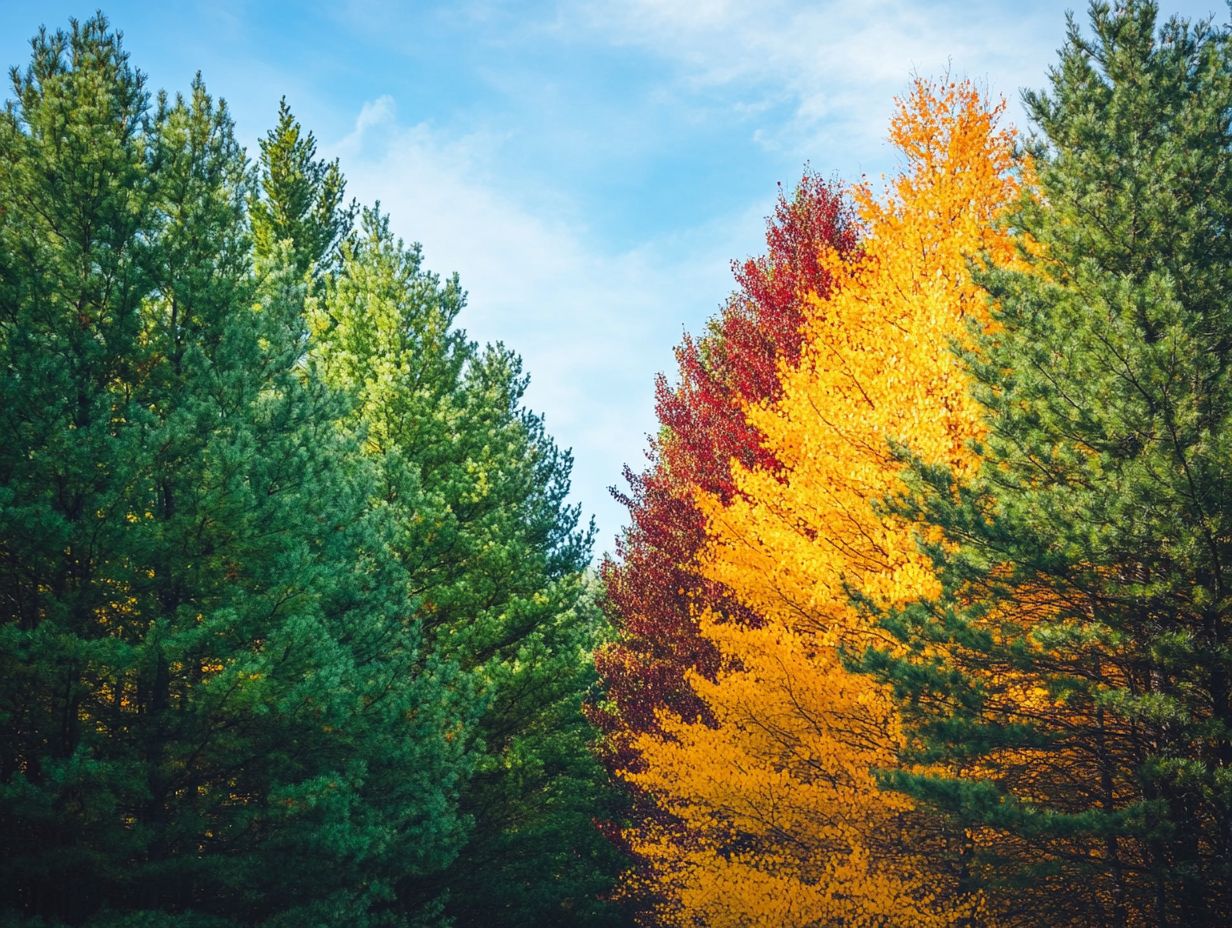
Both types of trees benefit the environment. Deciduous trees provide more oxygen and help with soil erosion. Evergreen trees offer year-round habitat for wildlife.
Do deciduous or evergreen trees require more maintenance?
This depends on the specific tree species and climate. Some deciduous trees may require more pruning and clean-up of fallen leaves, while evergreens may need trimming to maintain their shape.
Which type of tree is better for providing shade?
Deciduous trees are typically better for providing shade due to their larger leaves. However, evergreens can also provide shade and may be preferable in harsher climates.
Can deciduous and evergreen trees be planted together?
Yes, planting deciduous and evergreen trees together can enhance your landscape with year-round color and texture, attracting diverse wildlife.
How do I decide which type of tree is best for my yard?
Consider the climate, soil conditions, and desired function of the tree (shade, privacy, aesthetics) when choosing between deciduous and evergreen trees. Research specific tree species to ensure they thrive in your location.
Ready to enhance your landscape? Start planting today!

